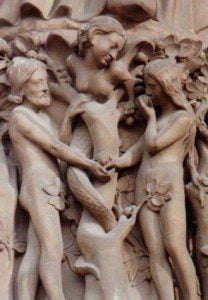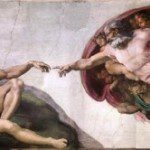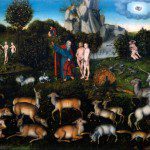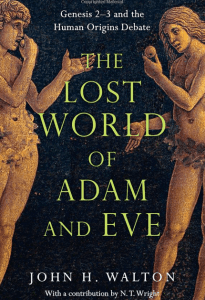 John Walton’s new book The Lost World of Adam and Eve: Genesis 2-3 and the Human Origins Debate explores a topic at the center of much of the controversy between science and Christian faith. Following the format used in his earlier books The Lost World of Genesis One and The Lost World of Scripture the chapters are organized according to propositions about the text and its interpretation. The first five propositions summarize concepts from the first two books and his more scholarly book Genesis 1 as Ancient Cosmology. These propositions focus on the nature of scripture and the interpretation of Genesis 1 to provide a necessary foundation for the move into Genesis 2 and 3 and the problem of Adam. Today’s post will outline the major ideas in this foundation.
John Walton’s new book The Lost World of Adam and Eve: Genesis 2-3 and the Human Origins Debate explores a topic at the center of much of the controversy between science and Christian faith. Following the format used in his earlier books The Lost World of Genesis One and The Lost World of Scripture the chapters are organized according to propositions about the text and its interpretation. The first five propositions summarize concepts from the first two books and his more scholarly book Genesis 1 as Ancient Cosmology. These propositions focus on the nature of scripture and the interpretation of Genesis 1 to provide a necessary foundation for the move into Genesis 2 and 3 and the problem of Adam. Today’s post will outline the major ideas in this foundation.
Genesis is an Ancient Document. The better we understand the ancient context, the better we will understand the message of the text. Walton will often remind us that Genesis was written for us but it was not written to us. As scripture it is for everyone, but this does not remove the need for continued study and interpretation. Every translation involves interpretation.
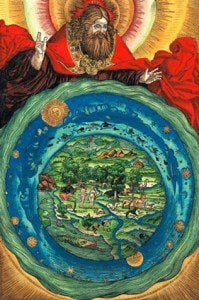 Some ideas in the text are incidental arising from the ancient Near Eastern culture, they are not part of the message of the text. For example, Genesis assumes that the waters above are separated from the waters below by a solid dome of some sort. Most people until very recently would have had no trouble believing this and it was a common view in the church, as the picture from Lucas Cranach included in Luther’s bible illustrates. Today we know this isn’t true and most don’t feel that this “error” undermines biblical authority. Likewise, we no longer view people as thinking with their intestines, even though this language is used in the text of scripture. Genesis isn’t a science text and it isn’t teaching science. We would do well to remember this and to avoid reading modern science back into the text or out of the text.
Some ideas in the text are incidental arising from the ancient Near Eastern culture, they are not part of the message of the text. For example, Genesis assumes that the waters above are separated from the waters below by a solid dome of some sort. Most people until very recently would have had no trouble believing this and it was a common view in the church, as the picture from Lucas Cranach included in Luther’s bible illustrates. Today we know this isn’t true and most don’t feel that this “error” undermines biblical authority. Likewise, we no longer view people as thinking with their intestines, even though this language is used in the text of scripture. Genesis isn’t a science text and it isn’t teaching science. We would do well to remember this and to avoid reading modern science back into the text or out of the text.
The need for expertise and scholarship to dig the depth of meaning from the text is simply a fact. We all walk alongside and stand on the shoulder of others as we read and study the text. Walton goes on:
Such study is not a violation of the clarity (“perspicuity”) of Scripture propagated by the reformers. They were not arguing that every part of Scripture was transparent to any casual reader. If they believed that, they would not have had to write hundreds of volumes trying to explain the complexities of interpretation at both exegetical and theological levels. They were, instead, trying to make the case that there was a “plain sense” of Scripture that was not esoteric, mystical, or allegorical and could only be spiritually discerned. Everyone could have access to this plain sense. (p. 22-23)
A better understanding of ancient Hebrew, ancient Near Eastern culture, literature, expectations, genres, styles, daily life, all of these will improve our understanding of Scripture. We need careful scholarship and we all need to pay attention to this scholarship.
Creating Focuses on Establishing Order by Assigning Functions. This is a big part of Walton’s overall argument. When we read Genesis 1 with modern eyes it seems obvious that the point is the material creation of the world. Before we can draw such a conclusion, however, we should dig into the text in its original context. Within the ancient Near East creation involves establishing order rather than producing material items. It isn’t that the latter is out of the question, it just isn’t the primary focus.
Our translations can illuminate and also obscure the ancient meaning of the text because every translation involves interpretation. Walton argues that the words translated made or created in Genesis 1 generally refer to establishing order or assigning function rather than to material creation. For example, “God made two great lights” could as easily be translates as “God provided two great lights” in the same way that God provided families for the midwives who defied pharaoh.
Genesis 1 Is an Account of Functional Origins. The starting point of Genesis 1 is a time without order or function. The actions of the seven days are aimed at establishing order. Separating light from dark and naming the times “day” and “night” establishes order. Separating the waters above from the waters below is also an act of establishing order and providing a space for life between these two expanses of water and regulates the weather. Separating dry ground and water naming them “land” and “seas” is an act of establishing order. The land then produces vegetation at God’s command.
In days one through three, we find that the discussion centers on the ordering of the world in terms of what could be identified as the major functions of human existence: time, weather, and food. These three would be recognized by any culture in any place, as they represent what all humans have recognized as providing a framework in which we exist. (pp. 37-38)
 Day four establishes lights in the sky – sun, moon, and stars, functionaries to govern the time produced in day one. These are not divine, but rather lights with designated functions. They separate and govern day and night and they “serve as signs to mark sacred times, and days and years”. It is not clear that the ancient Israelites regarded these as material objects at all. On day five God installs functionaries in the sea and air – sea creatures and birds. It is significant that the sea creatures, often thought ot as “chaos creatures” in the ancient Near East are assigned functions in Genesis. On day six God says “let the land produce living creatures.” In this text we should probably see an emphasis on a continuing process rather than a one time act of material formation. Walton suggests that the text might describe what the ancient person witnessed when young, birthed out of sight in seclusion, emerged from the land. The land gives forth animal life.
Day four establishes lights in the sky – sun, moon, and stars, functionaries to govern the time produced in day one. These are not divine, but rather lights with designated functions. They separate and govern day and night and they “serve as signs to mark sacred times, and days and years”. It is not clear that the ancient Israelites regarded these as material objects at all. On day five God installs functionaries in the sea and air – sea creatures and birds. It is significant that the sea creatures, often thought ot as “chaos creatures” in the ancient Near East are assigned functions in Genesis. On day six God says “let the land produce living creatures.” In this text we should probably see an emphasis on a continuing process rather than a one time act of material formation. Walton suggests that the text might describe what the ancient person witnessed when young, birthed out of sight in seclusion, emerged from the land. The land gives forth animal life.
Also on day six humans are “made” to perform a specific function as the image of God in the world. The image of God pertains to the role and function of humans, to the identity God has given humans, to humans serving as God’s substitute in the world, and to the relationship between God and humans. It applies to humans as a group, regardless of age, ability, or inability.
Walton sums up using an analogy of house versus home. Genesis 1 is concerned with ordering and filling a home, not with building a house. It uses the common understanding of the ancient audience to describe how God ordered and prepared the home.
God Orders the Cosmos as Sacred Space. Rest on day seven is the object of creation. This is when God comes to dwell in the home that has been prepared.
Sacred space is the result of divine presence and serves as the center and source of order in the cosmos. In this “home story,” God is not only making a home for people; he is making a home for himself, though he has no need of a home for himself. If God does not rest in this ordered space, the six days are without their guiding purpose. The cosmos is not just a house; it is a home. (p. 49)
And a few pages later, a summary of Walton’s proposal:
If the period of seven days is related to the inauguration of the cosmos as sacred space, it represents the period of transition from the material cosmos that has been prepared over the ages to being the place where God is going to relate to his people. It has changed from space to place. The seven days are related to the home story, not the house story – the ordering and establishing of functions, not the production of material objects. (p. 51)
When God establishes functional order, it is good. The Hebrew word translated good in Genesis and elsewhere in the Old Testament does not refer to unadulterated perfection. Conclusions based on the assumption that God’s “good” is identically equal to perfect are not warranted. Elsewhere in the Old Testament, the word is used to refer to God, indicating that he acts in good ways. It is also used to refer to humans where humans are good. Ecclesiastes 9 is a case in point. Here the text refers to humans who are good in contrast to those who are sinful. Good cannot mean unadulterated perfection. Finally, the word translated “good” is used to refer to things that are functioning in their designed role. “How good and pleasant it is when God’s people live together in unity!” Psalm 133:1.
I would conclude that “good” refers to a condition in which something is functioning optimally as it was designed to do in an ordered system – it is working the way God intended. (p. 55)
As a pilot might run down a preflight noting that all is functional, God is declaring each piece of his ordered creation good.
God saw all that he had made, and it was very good. And there was evening, and there was morning—the sixth day. God has prepared the order necessary for his plan. Humans are called to be agents in this plan – the continuing ordering process as they are fruitful and multiply, filling, subduing, and ruling. Some non-order remains, but the order that has been established is good and very good.
From here we can turn in the next proposition and the next post to the human ˀādām.
Do you find Walton’s proposal that Genesis 1 describes the creation of functional order convincing?
What is the purpose of this functional order?
What role should humans play?
If you wish to contact me, you may do so at rjs4mail[at]att.net.
If interested you can subscribe to a full text feed of my posts at Musings on Science and Theology.






